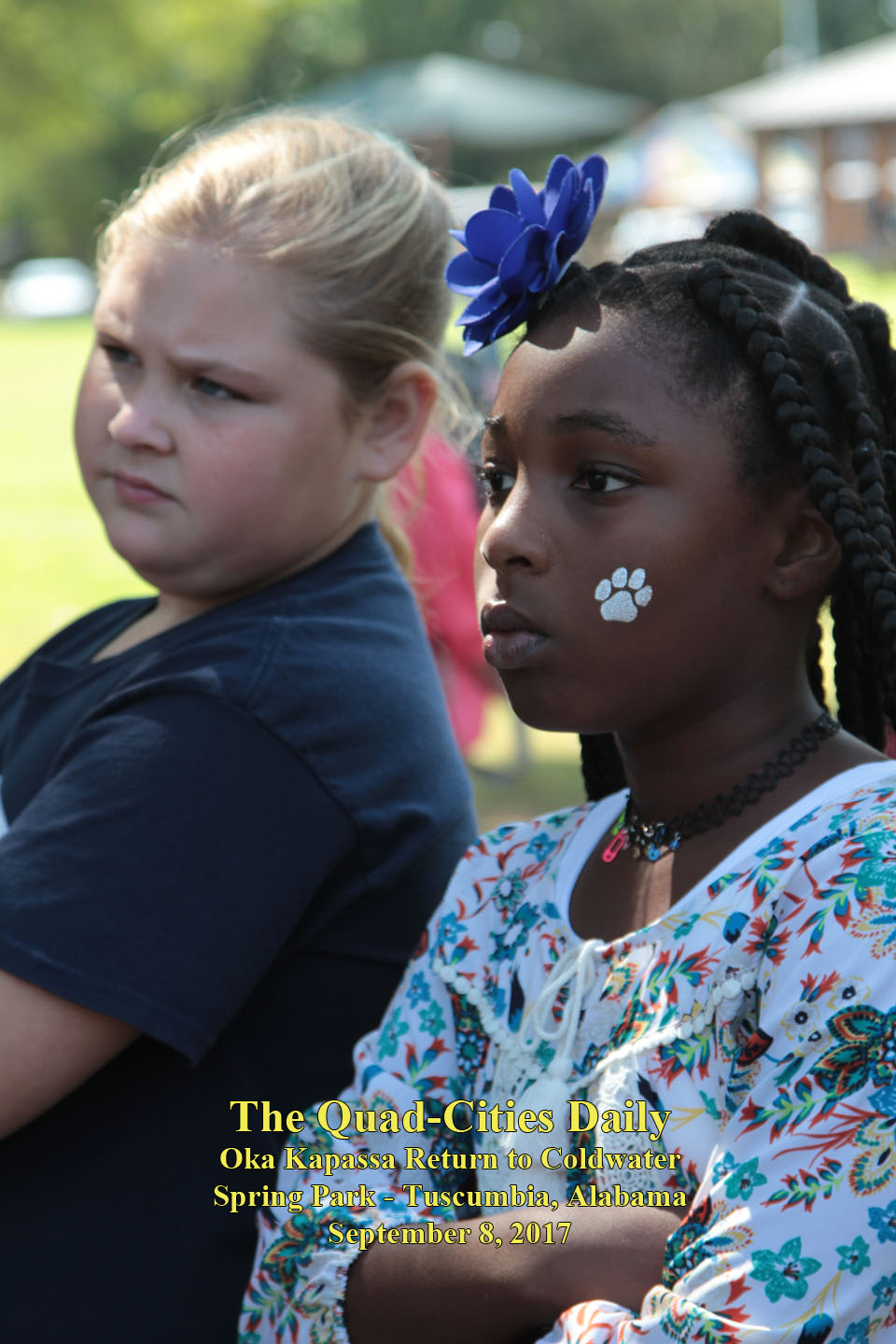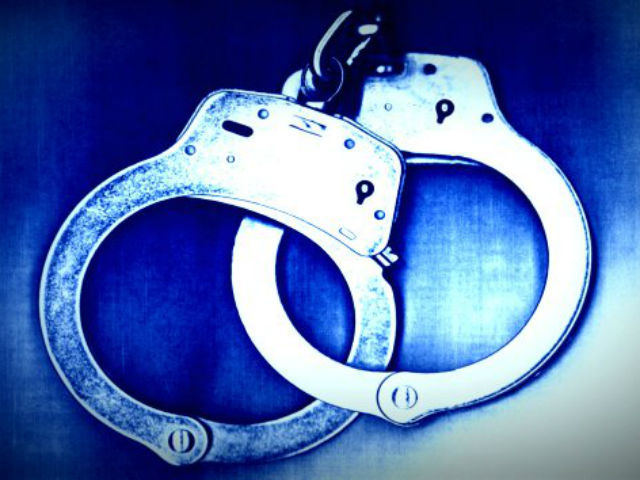 SHEFFIELD-TUSCUMBIA – The tenth annual “Walk to Tuscumbia” from Tuscumbia Landing along the Tennessee River in Sheffield to Spring Park took place Saturday September 8, 2012. Part of the Oka Kapassa Festival, the walk commemorates the kindness of the Citizens of Tuscumbia to the Native Americans who were forced to relocate to Oklahoma in The Great Indian Removal of 1830. Along the way they had encountered hardships, beatings, starvation and theft of their property on the Trail of Tears corridor except for their sojourn in the city of Tuscumbia. Here they were given food, clothes, shelter and medical attention before leaving the area at Tuscumbia Landing.
SHEFFIELD-TUSCUMBIA – The tenth annual “Walk to Tuscumbia” from Tuscumbia Landing along the Tennessee River in Sheffield to Spring Park took place Saturday September 8, 2012. Part of the Oka Kapassa Festival, the walk commemorates the kindness of the Citizens of Tuscumbia to the Native Americans who were forced to relocate to Oklahoma in The Great Indian Removal of 1830. Along the way they had encountered hardships, beatings, starvation and theft of their property on the Trail of Tears corridor except for their sojourn in the city of Tuscumbia. Here they were given food, clothes, shelter and medical attention before leaving the area at Tuscumbia Landing.
I was honored to be invited to the Colbert reunion potluck dinner the night before and met several of the descendants of Chief George Colbert and some of those who would be participating in the walk the next morning. I was treated to some of the best chicken stew I’ve ever put in my mouth.
I ventured down to Spring Park a little early before catching the trolley to Tuscumbia Landing The day was overcast and the clouds threatened rain again. A generous rain had occurred during the morning hours and combined with the abundance of geese made walking using the cowboy step (as my Dad called it on our dairy farm) necessary. The empty rocks of the waterfall added to the dreary feeling. The silence in the park was interrupted by a gaggle of Canadian geese flying into the park and landing in the pond near the bridge.
The walk from Tuscumbia Landing to Spring Park would take place even if it rained. After all those coming through Tuscumbia from as far away as Georgia suffered a lot more misery going to Oklahoma Annie Cooper pitched the idea of the walk to Tribal Council and the annual ‘homecoming’ walk was born. Instead of walking from Spring Park to Tuscumbia Landing, the walk commemorates the return home. Back to Oka Kapassa, meaning Cold Water, the name given to Spring Creek by the Chickasaws. The first walk had twenty participants. This year the trolley was packed and several walkers followed the trolley to the Landing in their cars. I didn’t do a head count, but this year’s walk had a lot more walkers than the first walk even with rain threatening.
 Rickey Butch Walker author of the recently released book ‘Chickasaw Chief George Colbert His Family & His Country’ and ‘Doublehead’ provided the following history of the landing: “The Tuscumbia Landing site was the location of the first military attack led by General James Robertson from Nashville, TN, on the Chickamauga town of Cold Water at the mouth of Cold Water Creek which had its beginning at Big Spring in present Tuscumbia, AL. On June 13, 1787, some of Doublehead’s warriors killed Mark Robertson, the younger brother of James Robertson near Nashville, TN. Without permission from the governor, James Robertson and 130 men began to pursue the enemy to the mouth of Blue Water Creek; they crossed the river and moved downstream to Cold Water village where Robertson’s forces killed some several Chickamaugans including 14 Lower Cherokees, six Upper Creeks, and some French traders.
Rickey Butch Walker author of the recently released book ‘Chickasaw Chief George Colbert His Family & His Country’ and ‘Doublehead’ provided the following history of the landing: “The Tuscumbia Landing site was the location of the first military attack led by General James Robertson from Nashville, TN, on the Chickamauga town of Cold Water at the mouth of Cold Water Creek which had its beginning at Big Spring in present Tuscumbia, AL. On June 13, 1787, some of Doublehead’s warriors killed Mark Robertson, the younger brother of James Robertson near Nashville, TN. Without permission from the governor, James Robertson and 130 men began to pursue the enemy to the mouth of Blue Water Creek; they crossed the river and moved downstream to Cold Water village where Robertson’s forces killed some several Chickamaugans including 14 Lower Cherokees, six Upper Creeks, and some French traders.
The Coosa Path or Muscle Shoals Path was a route around the shoals to Tuscumbia Landing; the first railroad west of the Appalachians also ran from Rhodes Ferry in Decatur to Tuscumbia. Hundreds of Cherokee people were transported around the Shoals via the rail line.”
Congress passed the Indian Removal Act in 1830 which forced approximately 100,000 Cherokees, Chickasaws, Choctaws, Creeks, and Seminoles to move from their homeland in the South to Oklahoma from 1830 to 1850. Approximately 3,500 Creeks died in Alabama during the removal.
 My most emotional moment was watching those who came from out of state and made the walk for the first time. Watching them put their hands on the Tuscumbia Landing historical sign and realizing that this was the site that their ancestors left on their forced removal in 1830 to Oklahoma.
My most emotional moment was watching those who came from out of state and made the walk for the first time. Watching them put their hands on the Tuscumbia Landing historical sign and realizing that this was the site that their ancestors left on their forced removal in 1830 to Oklahoma.
We took the trail from the parking lot down to the site of Tuscumbia Landing. All that is left of the building blown up by Union forces during the war is the foundation. The path of the railroad bed can still be seen, the tracks are long gone along with the oxen, horses and mules that pulled the first train. As I walked around the foundation and looked down the site of the track, I imagined what history this site saw, and what the Indians felt as they were removed from their homeland forever. A light rain started falling. I pulled out a plastic bag to wrap my camera in to protect it. After a couple of minutes, the rain went away.
The time came and everyone formed a circle. Robert Thrower was at the head of the circle started talking about his feelings and thoughts about what happened during the removal and the connections he had to Tuscumbia. Next representatives of each Tribe present shared their thoughts. A prayer was said at the end and it was time to start The Walk to Tuscumbia. The two mile walk started in silence by all for the first mile of our journey. The trolley followed behind for any who grew weary and couldn’t continue. The lead walker would rotate as we walked along. As we neared the city limits of Tuscumbia a buzzard circled. Then some one started singing in the native tongue. The chant continued until Oka Kapassa was reached. The walk finished as it had started, in prayer.
Annie Cooer’s thoughts about the walk: “Each year The Walk begins in memorial and ends in celebration. We do not plan what happens and this year was no exception. Each person spoke from their hearts including the Chickasaws, the Seminole, Creek and the Euchee. I found the songs both touching and inspiring. Rain was on most peoples minds and many brought their umbrella. Bob Perry, an elder with the Chickasaw Nation, spoke of the power of prayer and assured the crowd that it would not rain. It did not. A hawk flew over the walkers as if he was the escort and circled Spring Park as the participants arrived to find the crowd waiting to greet them. The group Inguinity played the song “Removal” in salute as the walkers returned. The Walk ended in Amazing Grace sung by the Chickasaw People.”
Rickey Butch Walker had the following thoughts: “As I walked past the huge oaks that line the old Coosa Path and the first rail line west of the Appalachians that led many of our Indian ancestors to Tuscumbia Landing, I wondered what these trees would say if they could talk; many tears were dropped Saturday, but I know many more were dropped by the people forced from their homes!”
.







